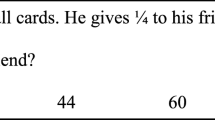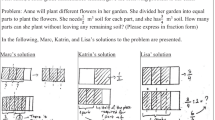Abstract
The goal of this study is to develop the professional noticing abilities of prospective elementary school teachers in the context of the Stages of Early Arithmetic Learning. In their mathematics methods course, ninety-four prospective elementary school teachers from three institutions participated in a researcher-developed five-session module that progressively nests the three interrelated components of professional noticing—attending, interpreting, and deciding. The module embeds video excerpts of diagnostic interviews of children doing mathematics (representations of practice) to prepare the prospective teachers for similar work. The module culminates with prospective teachers implementing similar diagnostic interviews (approximations of practice) to gain experience in the three component skills of professional noticing. A pre- and post-assessment was administered to measure prospective teachers’ change in the three components. A Wilcoxon signed ranks test was conducted and found the prospective elementary school teachers demonstrated significant growth in all three components. Selected prospective elementary school teacher responses on the pre- and post-assessment are provided to illustrate sample growth in the prospective teachers’ abilities to professionally notice. These results, the first in an ongoing study, indicate the potential that prospective teachers can develop professional noticing skills through this module. Continued data collection and analysis from the ongoing study by these authors and future, longer-term emphasis on professional noticing for prospective teachers should be studied.


Similar content being viewed by others
References
Ball, D. L. (1990). The mathematical understanding that prospective teachers bring to teacher education. The Elementary School Journal, 90, 449–466.
Ball, D. L., Forzani, F., Goldin, S., Noel, B., O’Neill, M. K., Pasek, L., et al. (2011). Resource document. Teaching works. http://www.teachingworks.org/work-of-teaching/high-leverage-content. Accessed March 4, 2012.
Boerst, T. A., Sleep, L., Ball, D. L., & Bass, H. (2011). Preparing teachers to lead mathematics discussions. Teachers College Record, 113(12), 2844–2877.
Carnegie Foundation for the Advancement of Teaching. (2010). Resource document. Carnegie Foundation. http://classifications.carnegiefoundation.org/descriptions/basic.php. Accessed March 13, 2012.
Carpenter, T. P., Fennema, E., Franke, M. L., Levi, L., & Empson, S. B. (1999). Children’s mathematics: Cognitively guided instruction. Portsmouth, NH: Heinemann.
Clements, D. H. (2007). Curriculum research: Toward a framework for “research-based curricula”. Journal for Research in Mathematics Education, 38, 35–70.
Glaser, B., & Strauss, A. (1967). The discovery of the grounded theory: Strategies for qualitative research. New York, NY: Aldine de Gruyter.
Grossman, P., Compton, C., Igra, D., Ronfeldt, M., Shahan, E., & Williamson, P. (2009). Teaching practice: A cross-professional perspective. Teachers College Record, 111, 2055–2100. http://www.tcrecord.org ID Number: 15018.
Grossman, P. (2011). Framework for teaching practice: A brief history of an idea. Teachers College Record, 113(12), 2836–2843.
Jacobs, V. R., Lamb, L. L. C., & Philipp, R. A. (2010). Professional noticing of children’s mathematical thinking. Journal for Research in Mathematics Education, 41(2), 169–202.
Kersting, N. B., Givvin, K. B., Sotelo, F. L., & Stigler, J. W. (2010). Teachers’ analyses of classroom video predict student learning of mathematics: Further explorations of a novel measure of teacher knowledge. Journal of Teacher Education, 61, 172–181.
Mason, J. (2011). Noticing: Roots and branches. In M. G. Sherin, V. R. Jacobs, & R. A. Philipp (Eds.), Mathematics teacher noticing: Seeing through teachers’ eyes (pp. 35–50). New York: Routledge.
Mulligan, J., Bobis, J., & Francis, C. (1999). Insights into early numeracy: The count me in too project. Australian Primary Mathematics Classroom, 4, 22–27.
National Council of Teachers of Mathematics. (2006). Curriculum focal points for prekindergarten through grade 8 mathematics. Reston, VA: NCTM.
Olive, J. (2001). Children’s number sequences: An explanation of Steffe’s constructs and an extrapolation to rational numbers of arithmetic. The Mathematics Educator, 11, 4–9.
Piaget, J. (1970). Genetic epistemology. New York: W.W. Norton.
Schifter, D., Bastable, V., & Russell, S. J. (2000). Developing mathematical ideas. Columbus, OH: Pearson Education.
Seago, N., Mumme, J., & Branca, N. (2004). Learning and teaching linear functions: Video cases for mathematics professional development. Portsmouth, NH: Heinemann.
Sherin, M. G., & van Es, E. A. (2009). Effects of video club participation on teachers’ professional vision. Journal of Teacher Education, 60, 20–37.
Sherin, M. G., Jacobs, V. R., & Philipp, R. A. (Eds.). (2011). Mathematics teacher noticing: Seeing through teachers’ eyes. New York: Routledge.
Sherin, B., & Star, J. R. (2011). Reflections on the study of teacher noticing. In M. G. Sherin, V. R. Jacobs, & R. A. Philipp (Eds.), Mathematics teacher noticing: Seeing through teachers’ eyes (pp. 66–78). New York: Routledge.
Star, J. R., & Strickland, S. K. (2008). Learning to observe: Using video to improve preservice mathematics teachers’ ability to notice. Journal of Mathematics Teacher Education, 11, 107–125.
Steffe, L. P., von Glasersfeld, E., Richards, J., & Cobb, P. (1983). Children’s counting types: Philosophy, theory, and application. New York: Praeger Scientific.
Steffe, L. P., Cobb, P., & von Glasersfeld, E. (1988). Construction of arithmetical meanings and strategies. New York: Springer.
Steffe, L. (1992). Learning stages in the construction of the number sequence. In J. Bideaud, C. Meljac, & J. Fischer (Eds.), Pathways to number: Children’s developing numerical abilities (pp. 83–88). Hillsdale, NJ: Lawrence Erlbaum.
Steffe, L. P., & Thompson, P. W. (2000). Teaching experiment methodology: Underlying principles and essential elements. In A. E. Kelly & R. A. Lesh (Eds.), Handbook of research design in mathematics and science education (pp. 267–306). Mahwah, NJ: Lawrence Erlbaum.
Thomas, J. (2010). Picture this: A doctoral dissertation examining children’s quantitative mental imagery. Unpublished doctoral dissertation, The University of Cincinnati.
Thomas, J., & Tabor, P. D. (2012). Differentiating instruction to facilitate quantitative mental imagery. Teaching Children Mathematics, 19, 174–183.
Wright, R. J., Martland, J., & Stafford, A. (2006). Early numeracy: Assessment for teaching and intervention (2nd ed.). London, UK: Paul Chapman Publications/Sage.
Acknowledgments
Research Funded by the National Science Foundation: Transforming Undergraduate Education in STEM (TUES) Collaborative Awards 1043667, 1043656, 1043831. The authors wish to thank Dr. Lenore Kinne, Northern Kentucky University, for her ongoing advice as evaluator of this project.
Author information
Authors and Affiliations
Corresponding author
Rights and permissions
About this article
Cite this article
Schack, E.O., Fisher, M.H., Thomas, J.N. et al. Prospective elementary school teachers’ professional noticing of children’s early numeracy. J Math Teacher Educ 16, 379–397 (2013). https://doi.org/10.1007/s10857-013-9240-9
Published:
Issue Date:
DOI: https://doi.org/10.1007/s10857-013-9240-9




